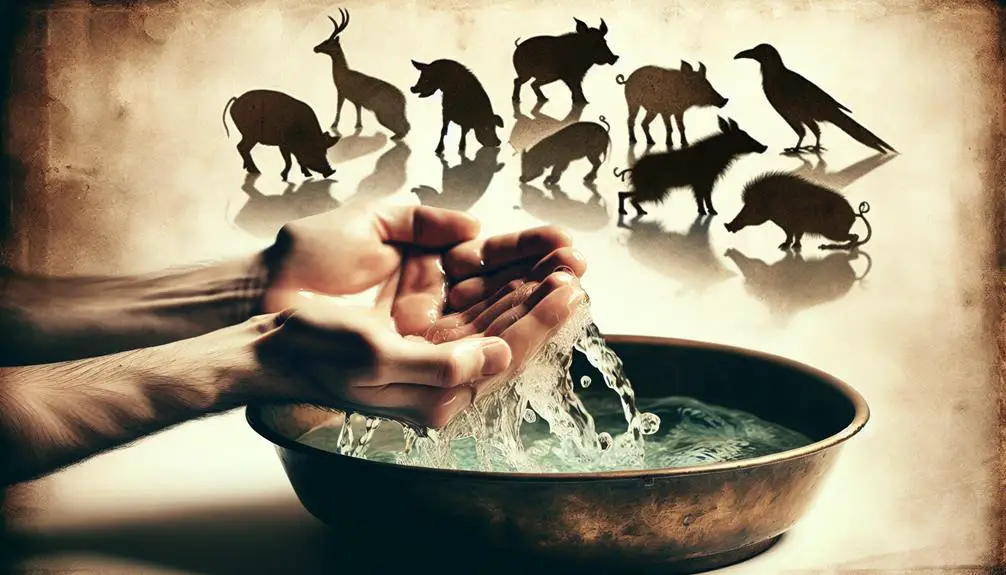From dietary laws to leprosy, explore the multifaceted concept of uncleanliness in the Bible and its impact on modern interpretations.

What Is Uncleanliness in the Bible
In the vast ocean of biblical teachings, the concept of uncleanliness might just cover more ground than Noah's floodwaters. You've probably encountered references to it, ranging from dietary laws to leprosy, but the layers and nuances are more intricate than you might think.
This ancient notion, deeply rooted in historical, cultural, and spiritual contexts, raises questions about purity, morality, and the human condition. As you explore the types of biblical uncleanliness, the rituals for cleansing, and its symbolism, you'll uncover how these ancient practices echo in modern interpretations and relevance.
Why does this matter today, you ask? Let's find out together, shall we?
Key Takeaways
- Uncleanliness in the Bible encompasses ritual purity laws, moral impurities, and dietary restrictions.
- It signifies both physical actions and spiritual implications, reflecting societal values and religious beliefs.
- Jesus' interactions with unclean individuals highlight themes of compassion, inclusion, and ethical living beyond religious boundaries.
- Modern interpretations of biblical uncleanliness emphasize its metaphorical relevance to ethical behavior and community values.
Historical Context of Uncleanliness

In examining the historical context of uncleanliness, it's crucial to understand that ancient societies, including those depicted in the Bible, had complex purity laws deeply intertwined with their spiritual, social, and health practices. These laws weren't merely arbitrary rules but were reflective of the cultural perceptions and social implications of the time. They served as a lens through which communities viewed their world, dictating interactions and societal structures.
You'll find that the notion of uncleanliness transcended mere physical dirt or filth; it encompassed a broader, more nuanced understanding of purity. This concept was pivotal in shaping group identity and individual behavior, as adherence to these purity laws was often seen as a manifestation of one's faithfulness and moral standing within the community. The social implications of being deemed unclean were significant, leading to isolation or exclusion from communal worship and social activities, thereby reinforcing the importance of maintaining ritual purity for both individual and collective well-being.
Moreover, cultural perceptions of uncleanliness weren't static; they evolved in response to changing social, environmental, and theological contexts. These perceptions were embedded in the fabric of daily life, influencing dietary choices, personal hygiene practices, and even the architecture of living spaces and places of worship.
Types of Biblical Uncleanliness

You'll find that the Bible categorizes uncleanliness through various lenses, including ritual purity laws, moral impurity examples, and dietary restrictions.
These categories not only reflect the complex socio-religious dynamics of ancient times but also offer insights into the moral and spiritual ethos guiding the community.
As we explore these types, you'll discern the intricate balance between physical actions and spiritual implications within the biblical narrative.
Ritual Purity Laws
The Bible delineates various forms of ritual purity laws, categorizing actions, and conditions that render individuals temporarily unclean. These laws intricately intertwine with societal norms, notably reflecting gender implications and the sanctity of priestly garments. The nuanced regulations underscore a complex theological framework, emphasizing holiness and the separation from the profane.
- Contact with the dead: Touching a corpse necessitates purification rituals.
- Skin diseases: Conditions like leprosy render a person unclean until healed.
- Bodily discharges: Certain emissions from the body require isolation and cleansing.
- Consumption of forbidden animals: Dietary laws specify clean and unclean animals.
- Childbirth: Postpartum women undergo a period of purification.
These laws served not only as a guide for maintaining physical cleanliness but also symbolized spiritual purity and communal cohesion.
Moral Impurity Examples
Biblical texts delineate moral impurity through actions and behaviors considered sinful, deeply impacting an individual's spiritual cleanliness and standing within the community. This dimension of uncleanliness extends beyond the realm of personal hygiene, addressing ethical dilemmas intrinsic to human nature.
For instance, acts of deceit, greed, and betrayal not only corrode personal integrity but also erode communal bonds, illustrating how moral impurity transcends physical contamination. Moreover, these narratives underscore the complexity of maintaining purity in a world rife with moral ambiguities.
Unlike the straightforward nature of keeping one's body clean, navigating the landscape of ethical dilemmas demands discernment and a deep engagement with one's values, highlighting the intertwined nature of physical and moral cleanliness in biblical thought.
Dietary Restrictions
In examining types of biblical uncleanliness, dietary restrictions emerge as a pivotal aspect, deeply rooted in the texts' moral and cultural landscapes. These regulations, while seemingly arbitrary to the modern observer, intertwine with ancient health benefits and culinary traditions, offering insights into the societal norms of the time.
- Pork avoidance: Reflecting concerns over diseases transmissible to humans.
- Shellfish restrictions: Likely due to their propensity to spoil rapidly.
- Prohibition of blood consumption: Stemming from beliefs about life essence.
- Distinction between clean and unclean birds: Reflecting dietary safety and religious symbolism.
- Avoidance of certain insects: Tied to health risks and cultural aversions.
These dietary laws not only regulated physical health but also reinforced communal identity through shared culinary traditions.
Rituals for Cleansing

You'll find the Bible outlines specific rituals for cleansing from uncleanliness, each with its own symbolic and practical significance.
Purification offerings, for instance, play a pivotal role in reinstating spiritual cleanliness, highlighting the intricate relationship between sin, guilt, and redemption.
Similarly, the procedures involving cleansing waters and the detailed laws for the purification of leprosy underscore the broader theological and societal implications of purity in biblical times.
Purification Offerings Explained
Purification offerings, central to ancient Hebrew rituals for cleansing, required specific actions and materials to restore spiritual cleanliness. These practices, deeply rooted in the theological and cultural fabric of the time, aimed to bridge the gap between the divine and the human, primarily through animal sacrifices and blood sprinkling. This process underscores the seriousness with which uncleanliness was regarded and the lengths to which individuals would go to ensure their spiritual purity.
- *Animal sacrifices*: A primary component, varying by the individual's means.
- *Blood sprinkling*: Symbolized purification, transferring uncleanliness.
- *Specific animals*: Typically unblemished lambs or doves.
- *Priests' role*: Mediated between the individual and the divine.
- *Intention and confession*: Essential for the offering's acceptance.
Analyzing these elements reveals the intricate balance between physical actions and spiritual intentions in achieving purification.
Cleansing Waters Rituals
While purification offerings involved specific actions and materials, cleansing waters rituals similarly played a crucial role in achieving spiritual cleanliness through immersive practices.
You'd observe that these rituals, deeply rooted in hygienic practices, underscored the cultural significance of purity in the ancient context. By immersing oneself or specific objects in water, participants symbolically removed impurities, aligning physical cleanliness with spiritual purity.
This act wasn't merely about physical hygiene; it was a profound expression of repentance and renewal, reflecting a community's collective ethos towards sanctity. Such practices highlight the intricate relationship between the physical and the spiritual, demonstrating how external actions could influence internal states.
The detailed rituals provided a structured means to restore one's standing within the community, emphasizing the holistic nature of purity in biblical times.
Leprosy Cleansing Laws
In the biblical tradition, leprosy cleansing laws prescribe a complex series of rituals aimed at reinstating spiritual and communal purity for individuals diagnosed with this condition. The leprosy stigma, deeply embedded in these texts, reflects a broader apprehension towards diseases, intertwining the medical perspective with spiritual purification.
- Examination by a Priest: A crucial step to confirm the diagnosis, blending the spiritual and medical perspective.
- Isolation: Temporarily separates the afflicted from the community, highlighting societal fears.
- Sacrificial Offerings: Symbolize repentance and supplication for divine intervention.
- Hyssop and Cedarwood: Employed in purification rituals, representing cleansing and strength.
- Reintegration Ceremony: Marks the end of isolation, restoring the individual's place in society.
This intricate process underscores the interplay between health, spirituality, and community in ancient texts.
Symbolism in Uncleanliness

Delving into the symbolism of uncleanliness, you'll find that it often represents moral or spiritual impurity within biblical narratives. This concept transcends the mere physical state, suggesting a deeper, more profound understanding of human behavior and its consequences. The symbolic meanings ascribed to uncleanliness are intricately connected with cultural interpretations, which vary significantly across different societies but converge on the idea of separation from the divine or a state of sin.
In analyzing these symbolic meanings, it's crucial to consider the context in which uncleanliness is discussed. The Bible frequently uses physical impurity to illustrate moral lessons, signaling a departure from God's law and the path of righteousness. This allegorical use of uncleanliness serves as a vivid reminder of the consequences of sin, both on an individual and communal level.
Moreover, the cultural interpretations of uncleanliness within biblical times offer a window into the societal norms and values of the period. These norms shaped the understanding of purity, both physically and spiritually, emphasizing the importance of adhering to God's commandments. The concept of uncleanliness, therefore, can be seen as a tool for social regulation, promoting cohesion and obedience among the community members.
Jesus and Uncleanliness

Turning our attention to Jesus and uncleanliness, we observe a transformative approach that challenges traditional views and emphasizes inclusivity and compassion over strict adherence to purity laws. Jesus' ministry marked a significant shift from the Old Testament's detailed regulations on uncleanliness to a new paradigm that prioritized human well-being and spiritual purity over ceremonial cleanliness. This shift is evident through numerous accounts of Jesus' interactions with those considered unclean in Jewish society.
- Healing the leper: In defying societal norms, Jesus touched and healed lepers, who were quintessentially unclean, showcasing His power over impurity and His disregard for conventional purity laws in favor of mercy.
- Cleansing a possessed man: Jesus' miraculous healing of a man possessed by a legion of demons in Gadarenes demonstrates His authority over spiritual uncleanliness and His willingness to restore those ostracized by society.
- Healing the woman with an issue of blood: By healing a woman considered perpetually unclean due to her condition, Jesus highlighted His compassion acts over the ceremonial law, inviting those marginalized back into community life.
- Raising the dead: Touching the dead was a significant source of impurity, yet Jesus raised individuals from the dead, transcending traditional boundaries to affirm His dominion over life and death.
- Eating with sinners: Jesus frequently dined with those deemed spiritually unclean, emphasizing that His mission was to heal and save the lost, challenging social and religious exclusivity.
Through these actions, Jesus redefined uncleanliness, focusing not on external adherence but on internal transformation, compassion acts, and miraculous healings. His approach invites a reevaluation of purity, emphasizing the heart's condition over ritual conformity.
Modern Interpretations and Relevance

Reflecting on Jesus' approach to uncleanliness, we now explore its modern interpretations and relevance, considering how these ancient narratives influence contemporary perspectives on purity, compassion, and community inclusion. The biblical principles of cleanliness have evolved, yet their foundational values—such as the ethical implications of our actions and the societal impacts of exclusion—remain pertinent. You'll find that current discourse on these topics often intersects with discussions on public health, social justice, and personal morality.
Aspect |
Modern Interpretation |
|---|---|
Purity |
Not just a physical state but a metaphor for ethical living and moral integrity. |
Compassion |
Extending beyond religious boundaries to promote universal empathy and kindness. |
Community Inclusion |
Emphasizing inclusivity and rejecting practices that marginalize individuals. |
In this context, uncleanliness transcends its literal sense, inviting you to ponder the broader ethical implications of your actions. How do your choices affect others' well-being? Are you contributing to a community that values and promotes inclusivity?
Moreover, the societal impacts of these interpretations cannot be overstated. By understanding uncleanliness not merely as a physical or spiritual condition but as a reflection of societal values, you engage in a deeper analysis of what it means to live in a community. This approach challenges you to consider how ancient wisdom can inform modern practices, encouraging a society that prioritizes compassion, purity of intention, and inclusivity.
Frequently Asked Questions
How Do Non-Abrahamic Religions View the Concept of Uncleanliness, and What Parallels Can Be Drawn to the Biblical Understanding?
In non-Abrahamic religions, you'll find that ritual purification and symbolic meanings of uncleanliness often mirror those in the Bible. These traditions view impurities as obstacles to spiritual purity, requiring specific rituals to cleanse oneself.
Whether it's through water, prayer, or other means, the core idea is that purity facilitates closer divine connection. This parallel underlines a universal human inclination towards ritual as a means of transcending earthly impurities.
In What Ways Has the Psychological Impact of Being Deemed "Unclean" Affected Individuals and Communities Throughout History, According to Biblical Narratives?
In history, being branded 'unclean' wasn't just a fashion faux pas; it led to social stigma and emotional trauma. This label, often doled out for various reasons, wasn't just about hygiene but had profound psychological effects.
Communities marginalized those tagged 'unclean,' leading to isolation and a sense of worthlessness. Analyzing biblical narratives reveals the deep-seated impact of uncleanliness, underscoring how societal judgments can scar individuals and fracture communities.
Can Biblical Uncleanliness Be Linked to the Development of Public Health Practices in Ancient Societies?
Yes, you can trace public health origins to biblical uncleanliness, influencing ancient sanitation practices. This concept emphasized cleanliness, leading societies to adopt early health measures.
By analyzing these traditions, you'll see a sophisticated understanding of disease prevention. It's not just about spiritual purity; these practices laid the groundwork for modern public health systems.
They recognized the link between hygiene and health, showing an early grasp of environmental and communal well-being.
How Have Artists and Writers Throughout History Depicted or Interpreted Biblical Uncleanliness in Their Works?
Throughout history, artists and writers have woven biblical uncleanliness into their works, using artistic symbolism to explore its nuances. They've delved into cultural representation, portraying these themes in ways that reflect societal attitudes and beliefs of their times.
What Role Does Uncleanliness Play in the Dietary Restrictions Found in the Bible, and How Does This Compare to Dietary Laws in Other Religious Texts?
In the Bible, uncleanliness significantly influences dietary restrictions, guiding what you can eat. Modern interpretations often compare these rules to dietary laws in other religious texts, noting similarities and differences. Cultural adaptations have shifted perceptions, yet the core principles remain influential.
Analyzing these dietary laws illuminates how religions navigate purity, health, and spiritual well-being, offering a detailed, scholarly perspective on the complex interplay between faith, food, and cultural evolution.
Conclusion
In conclusion, the concept of uncleanliness in the Bible encompasses a complex interplay of religious, cultural, and symbolic dimensions, deeply rooted in historical practices and beliefs.
Interestingly, a study found that over 70 references to uncleanliness exist in the Old Testament alone, underlining its significance in ancient Jewish law and tradition.
This multifaceted notion, from ritual impurity to moral metaphor, not only highlights the intricate relationship between purity and religious observance but also invites a nuanced understanding of its implications and adaptations in contemporary spirituality.



Sign up